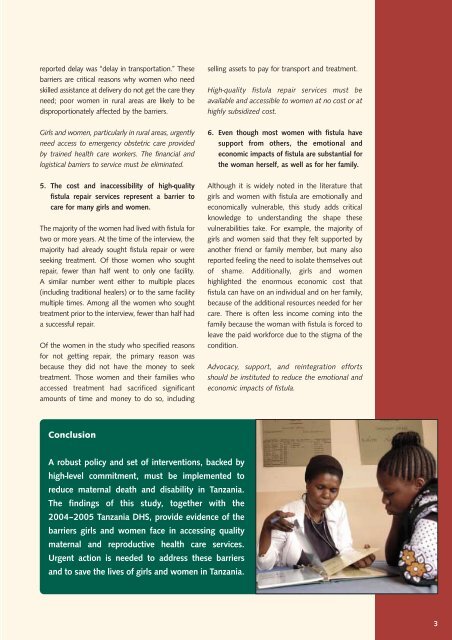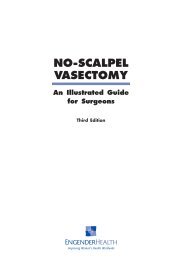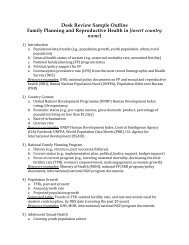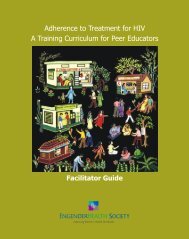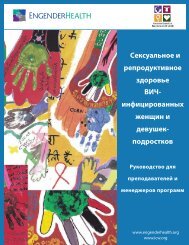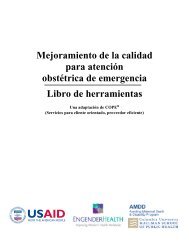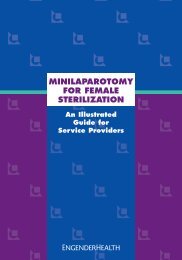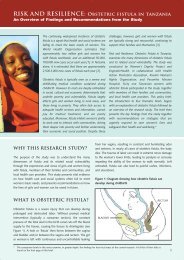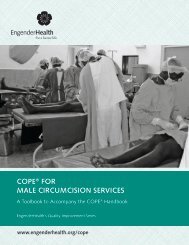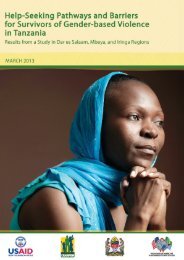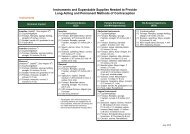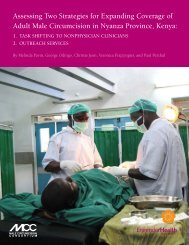Risk and Resilience: Obstetric Fistula in Tanzania - EngenderHealth
Risk and Resilience: Obstetric Fistula in Tanzania - EngenderHealth
Risk and Resilience: Obstetric Fistula in Tanzania - EngenderHealth
You also want an ePaper? Increase the reach of your titles
YUMPU automatically turns print PDFs into web optimized ePapers that Google loves.
eported delay was “delay <strong>in</strong> transportation.” These<br />
barriers are critical reasons why women who need<br />
skilled assistance at delivery do not get the care they<br />
need; poor women <strong>in</strong> rural areas are likely to be<br />
disproportionately affected by the barriers.<br />
Girls <strong>and</strong> women, particularly <strong>in</strong> rural areas, urgently<br />
need access to emergency obstetric care provided<br />
by tra<strong>in</strong>ed health care workers. The f<strong>in</strong>ancial <strong>and</strong><br />
logistical barriers to service must be elim<strong>in</strong>ated.<br />
5. The cost <strong>and</strong> <strong>in</strong>accessibility of high-quality<br />
fistula repair services represent a barrier to<br />
care for many girls <strong>and</strong> women.<br />
The majority of the women had lived with fistula for<br />
two or more years. At the time of the <strong>in</strong>terview, the<br />
majority had already sought fistula repair or were<br />
seek<strong>in</strong>g treatment. Of those women who sought<br />
repair, fewer than half went to only one facility.<br />
A similar number went either to multiple places<br />
(<strong>in</strong>clud<strong>in</strong>g traditional healers) or to the same facility<br />
multiple times. Among all the women who sought<br />
treatment prior to the <strong>in</strong>terview, fewer than half had<br />
a successful repair.<br />
Of the women <strong>in</strong> the study who specified reasons<br />
for not gett<strong>in</strong>g repair, the primary reason was<br />
because they did not have the money to seek<br />
treatment. Those women <strong>and</strong> their families who<br />
accessed treatment had sacrificed significant<br />
amounts of time <strong>and</strong> money to do so, <strong>in</strong>clud<strong>in</strong>g<br />
sell<strong>in</strong>g assets to pay for transport <strong>and</strong> treatment.<br />
High-quality fistula repair services must be<br />
available <strong>and</strong> accessible to women at no cost or at<br />
highly subsidized cost.<br />
6. Even though most women with fistula have<br />
support from others, the emotional <strong>and</strong><br />
economic impacts of fistula are substantial for<br />
the woman herself, as well as for her family.<br />
Although it is widely noted <strong>in</strong> the literature that<br />
girls <strong>and</strong> women with fistula are emotionally <strong>and</strong><br />
economically vulnerable, this study adds critical<br />
knowledge to underst<strong>and</strong><strong>in</strong>g the shape these<br />
vulnerabilities take. For example, the majority of<br />
girls <strong>and</strong> women said that they felt supported by<br />
another friend or family member, but many also<br />
reported feel<strong>in</strong>g the need to isolate themselves out<br />
of shame. Additionally, girls <strong>and</strong> women<br />
highlighted the enormous economic cost that<br />
fistula can have on an <strong>in</strong>dividual <strong>and</strong> on her family,<br />
because of the additional resources needed for her<br />
care. There is often less <strong>in</strong>come com<strong>in</strong>g <strong>in</strong>to the<br />
family because the woman with fistula is forced to<br />
leave the paid workforce due to the stigma of the<br />
condition.<br />
Advocacy, support, <strong>and</strong> re<strong>in</strong>tegration efforts<br />
should be <strong>in</strong>stituted to reduce the emotional <strong>and</strong><br />
economic impacts of fistula.<br />
Conclusion<br />
A robust policy <strong>and</strong> set of <strong>in</strong>terventions, backed by<br />
high-level commitment, must be implemented to<br />
reduce maternal death <strong>and</strong> disability <strong>in</strong> <strong>Tanzania</strong>.<br />
The f<strong>in</strong>d<strong>in</strong>gs of this study, together with the<br />
2004–2005 <strong>Tanzania</strong> DHS, provide evidence of the<br />
barriers girls <strong>and</strong> women face <strong>in</strong> access<strong>in</strong>g quality<br />
maternal <strong>and</strong> reproductive health care services.<br />
Urgent action is needed to address these barriers<br />
<strong>and</strong> to save the lives of girls <strong>and</strong> women <strong>in</strong> <strong>Tanzania</strong>.<br />
3


